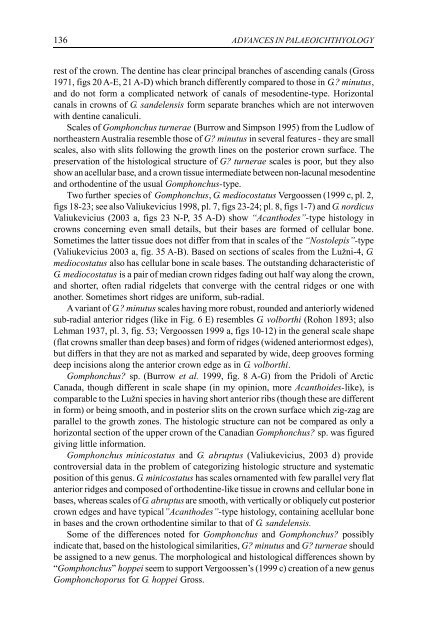Zemes un vides zinātnes Earth and Environment Sciences - Latvijas ...
Zemes un vides zinātnes Earth and Environment Sciences - Latvijas ...
Zemes un vides zinātnes Earth and Environment Sciences - Latvijas ...
You also want an ePaper? Increase the reach of your titles
YUMPU automatically turns print PDFs into web optimized ePapers that Google loves.
136<br />
ADVANCES IN PALAEOICHTHYOLOGY<br />
rest of the crown. The dentine has clear principal branches of ascending canals (Gross<br />
1971, figs 20 A-E, 21 A-D) which branch differently compared to those in G.? minutus,<br />
<strong>and</strong> do not form a complicated network of canals of mesodentine-type. Horizontal<br />
canals in crowns of G. s<strong>and</strong>elensis form separate branches which are not interwoven<br />
with dentine canaliculi.<br />
Scales of Gomphonchus turnerae (Burrow <strong>and</strong> Simpson 1995) from the Ludlow of<br />
northeastern Australia resemble those of G? minutus in several features - they are small<br />
scales, also with slits following the growth lines on the posterior crown surface. The<br />
preservation of the histological structure of G? turnerae scales is poor, but they also<br />
show an acellular base, <strong>and</strong> a crown tissue intermediate between non-lac<strong>un</strong>al mesodentine<br />
<strong>and</strong> orthodentine of the usual Gomphonchus-type.<br />
Two further species of Gomphonchus, G. mediocostatus Vergoossen (1999 c, pl. 2,<br />
figs 18-23; see also Valiukevicius 1998, pl. 7, figs 23-24; pl. 8, figs 1-7) <strong>and</strong> G. nordicus<br />
Valiukevicius (2003 a, figs 23 N-P, 35 A-D) show “Acanthodes”-type histology in<br />
crowns concerning even small details, but their bases are formed of cellular bone.<br />
Sometimes the latter tissue does not differ from that in scales of the “Nostolepis”-type<br />
(Valiukevicius 2003 a, fig. 35 A-B). Based on sections of scales from the Lužni-4, G.<br />
mediocostatus also has cellular bone in scale bases. The outst<strong>and</strong>ing dcharacteristic of<br />
G. mediocostatus is a pair of median crown ridges fading out half way along the crown,<br />
<strong>and</strong> shorter, often radial ridgelets that converge with the central ridges or one with<br />
another. Sometimes short ridges are <strong>un</strong>iform, sub-radial.<br />
A variant of G.? minutus scales having more robust, ro<strong>un</strong>ded <strong>and</strong> anteriorly widened<br />
sub-radial anterior ridges (like in Fig. 6 E) resembles G. volborthi (Rohon 1893; also<br />
Lehman 1937, pl. 3, fig. 53; Vergoossen 1999 a, figs 10-12) in the general scale shape<br />
(flat crowns smaller than deep bases) <strong>and</strong> form of ridges (widened anteriormost edges),<br />
but differs in that they are not as marked <strong>and</strong> separated by wide, deep grooves forming<br />
deep incisions along the anterior crown edge as in G. volborthi.<br />
Gomphonchus? sp. (Burrow et al. 1999, fig. 8 A-G) from the Pridoli of Arctic<br />
Canada, though different in scale shape (in my opinion, more Acanthoides-like), is<br />
comparable to the Lužni species in having short anterior ribs (though these are different<br />
in form) or being smooth, <strong>and</strong> in posterior slits on the crown surface which zig-zag are<br />
parallel to the growth zones. The histologic structure can not be compared as only a<br />
horizontal section of the upper crown of the Canadian Gomphonchus? sp. was figured<br />
giving little information.<br />
Gomphonchus minicostatus <strong>and</strong> G. abruptus (Valiukevicius, 2003 d) provide<br />
controversial data in the problem of categorizing histologic structure <strong>and</strong> systematic<br />
position of this genus. G. minicostatus has scales ornamented with few parallel very flat<br />
anterior ridges <strong>and</strong> composed of orthodentine-like tissue in crowns <strong>and</strong> cellular bone in<br />
bases, whereas scales of G. abruptus are smooth, with vertically or obliquely cut posterior<br />
crown edges <strong>and</strong> have typical”Acanthodes”-type histology, containing acellular bone<br />
in bases <strong>and</strong> the crown orthodentine similar to that of G. s<strong>and</strong>elensis.<br />
Some of the differences noted for Gomphonchus <strong>and</strong> Gomphonchus? possibly<br />
indicate that, based on the histological similarities, G? minutus <strong>and</strong> G? turnerae should<br />
be assigned to a new genus. The morphological <strong>and</strong> histological differences shown by<br />
“Gomphonchus” hoppei seem to support Vergoossen’s (1999 c) creation of a new genus<br />
Gomphonchoporus for G. hoppei Gross.
















